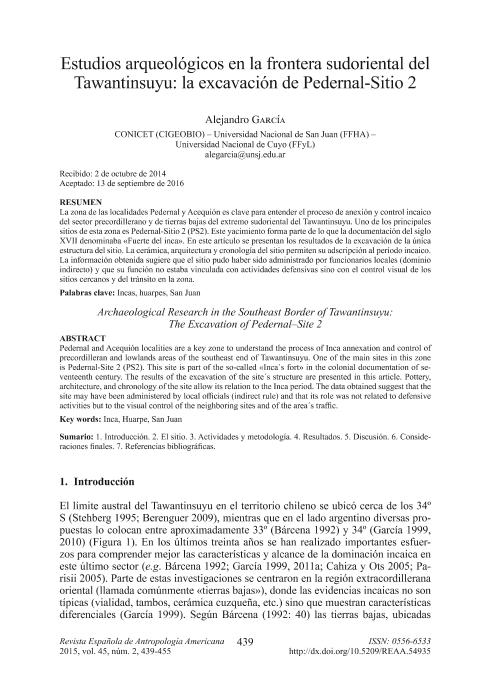Artículo
La zona de las localidades Pedernal y Acequión es clave para entender el proceso de anexión y control incaico del sector precordillerano y de tierras bajas del extremo sudoriental del Tawantinsuyu. Uno de los principales sitios de esta zona es Pedernal-Sitio 2 (PS2). Este yacimiento forma parte de lo que la documentación del siglo XVII denominaba «Fuerte del inca». En este artículo se presentan los resultados de la excavación de la única estructura del sitio. La cerámica, arquitectura y cronología del sitio permiten su adscripción al período incaico. La información obtenida sugiere que el sitio pudo haber sido administrado por funcionarios locales (dominio indirecto) y que su función no estaba vinculada con actividades defensivas sino con el control visual de los sitios cercanos y del tránsito en la zona. Pedernal and Acequión localities are a key zone to understand the process of Inca annexation and control of precordilleran and lowlands areas of the southeast end of Tawantinsuyu. One of the main sites in this zone is Pedernal-Site 2 (PS2). This site is part of the so-called «Inca's fort» in the colonial documentation of seventeenth century. The results of the excavation of the site's structure are presented in this article. Pottery, architecture, and chronology of the site allow its relation to the Inca period. The data obtained suggest that the site may have been administered by local officials (indirect rule) and that its role was not related to defensive activities but to the visual control of the neighboring sites and of the area's traffic.
Estudios arqueológicos en la frontera sudoriental del Tawantinsuyu: la excavación de Pedernal-Sitio 2
Título:
Archaeological Research in the Southeast Border of Tawantinsuyu: The Excavation of Pedernal–Site 2
Fecha de publicación:
07/2016
Editorial:
Universidad Complutense de Madrid
Revista:
Revista Española de Antropología Americana
ISSN:
0556-6533
e-ISSN:
1988-2718
Idioma:
Español
Tipo de recurso:
Artículo publicado
Clasificación temática:
Resumen
Archivos asociados
Licencia
Identificadores
Colecciones
Articulos(CIGEOBIO)
Articulos de CENTRO DE INVESTIGACIONES DE LA GEOSFERA Y BIOSFERA
Articulos de CENTRO DE INVESTIGACIONES DE LA GEOSFERA Y BIOSFERA
Citación
García, Eduardo Alejandro; Estudios arqueológicos en la frontera sudoriental del Tawantinsuyu: la excavación de Pedernal-Sitio 2; Universidad Complutense de Madrid; Revista Española de Antropología Americana; 45; 2; 7-2016; 439-455
Compartir




